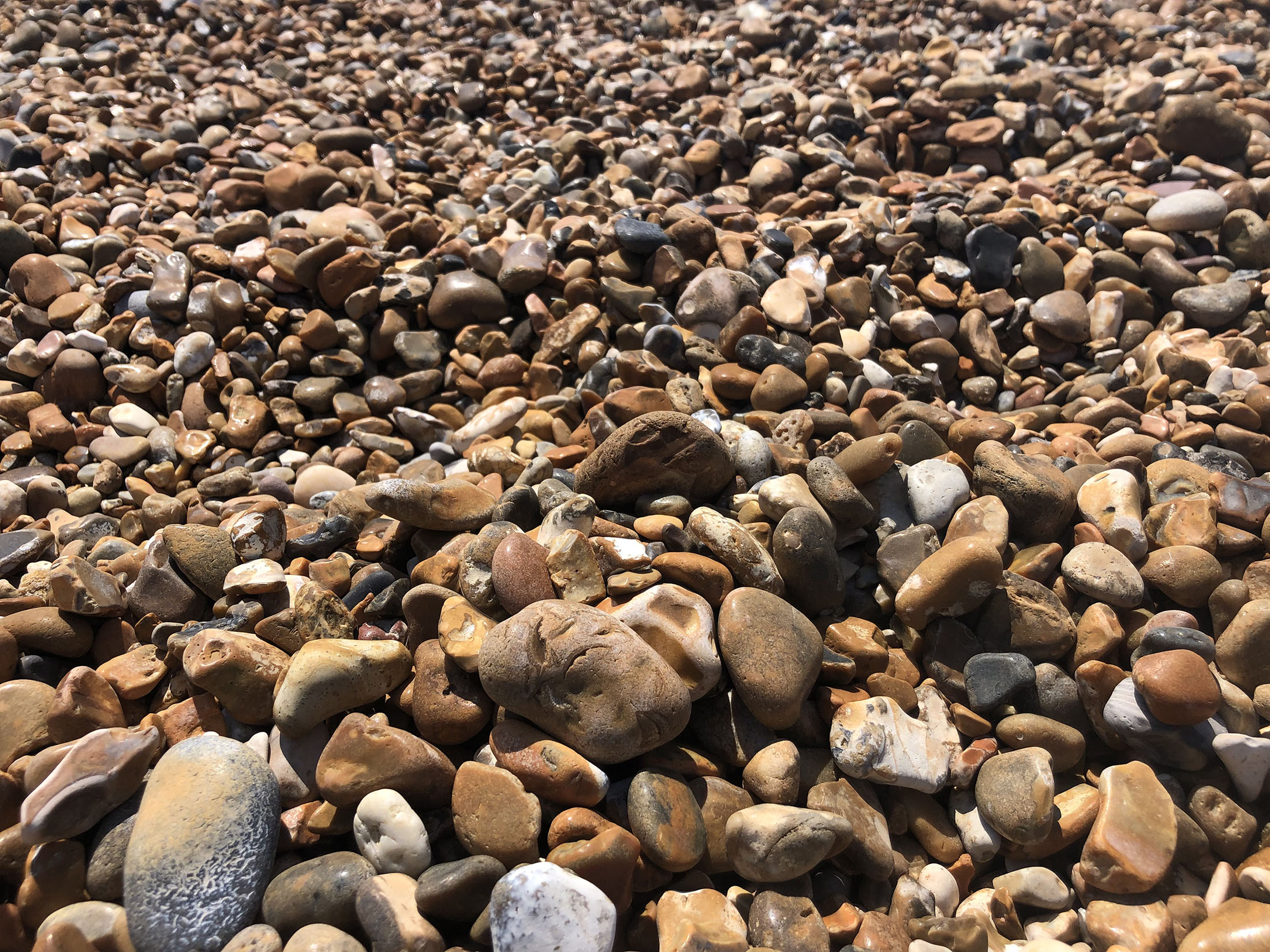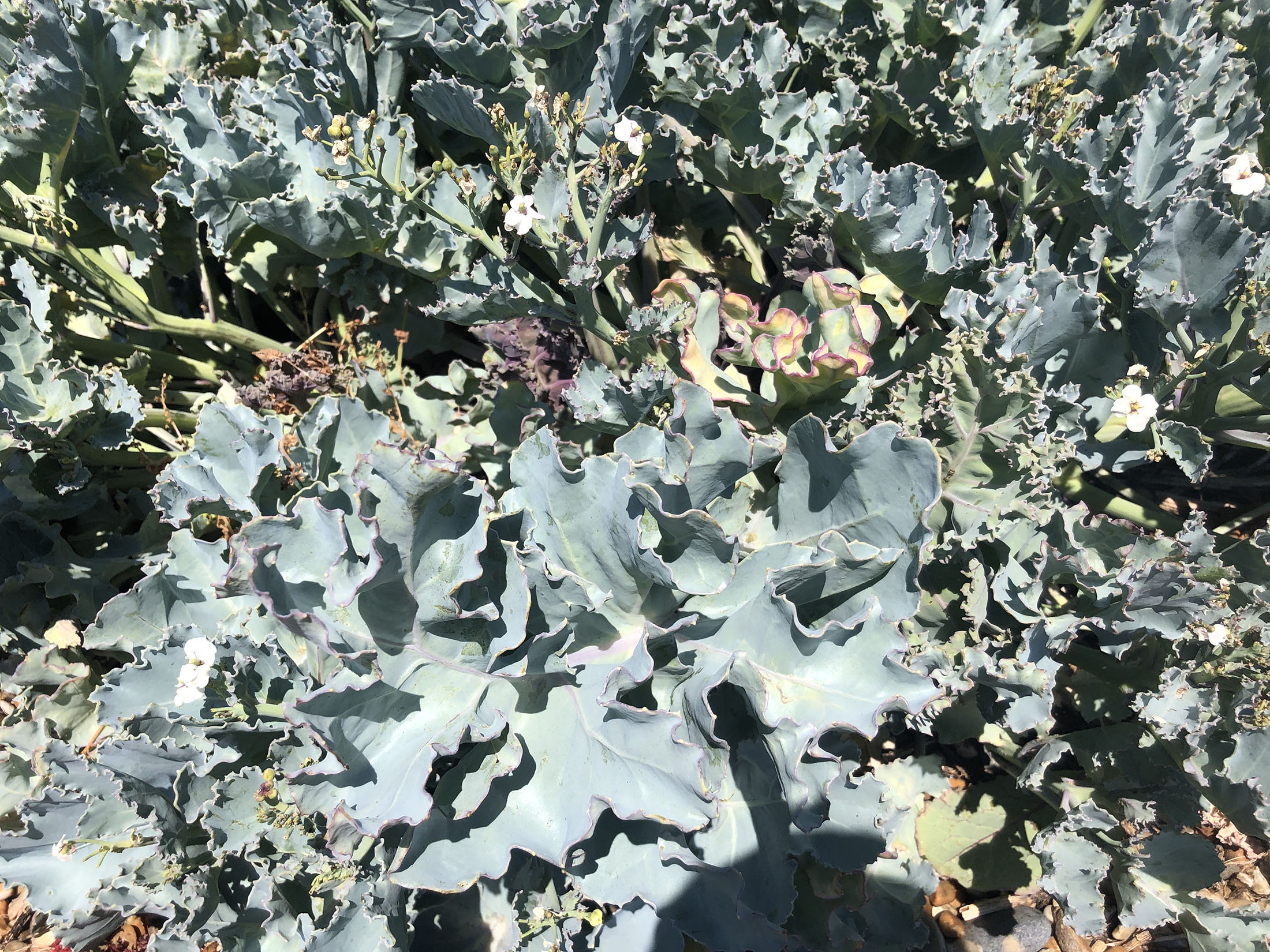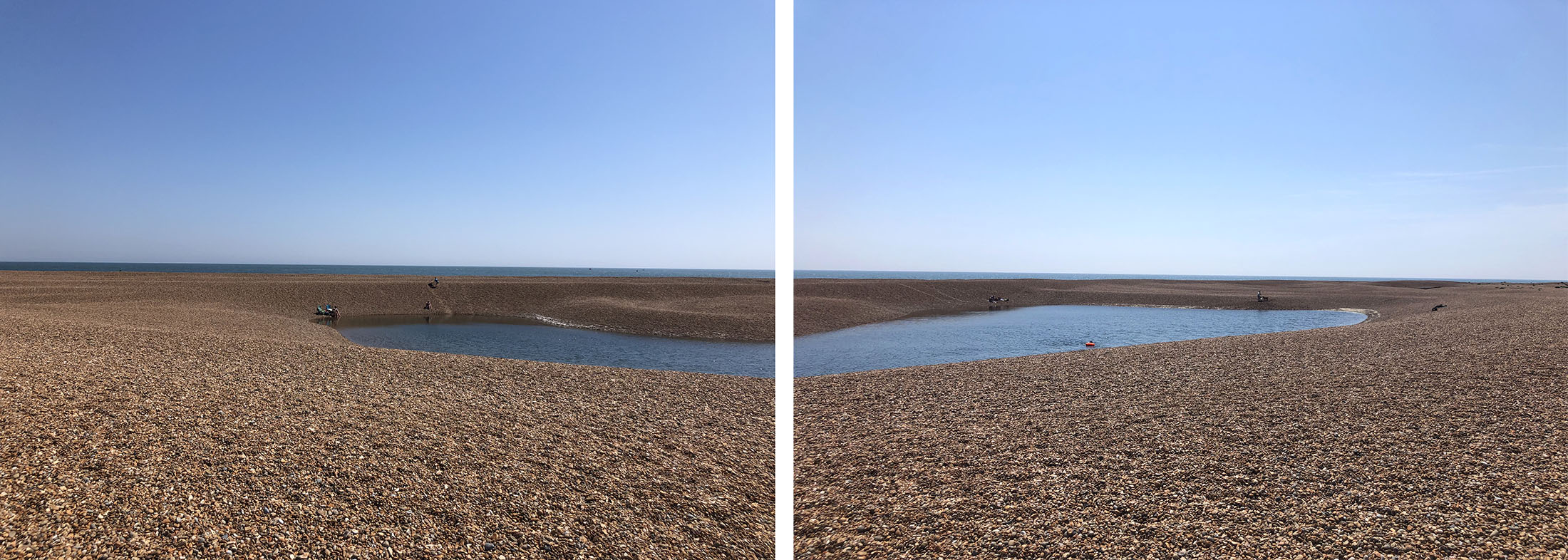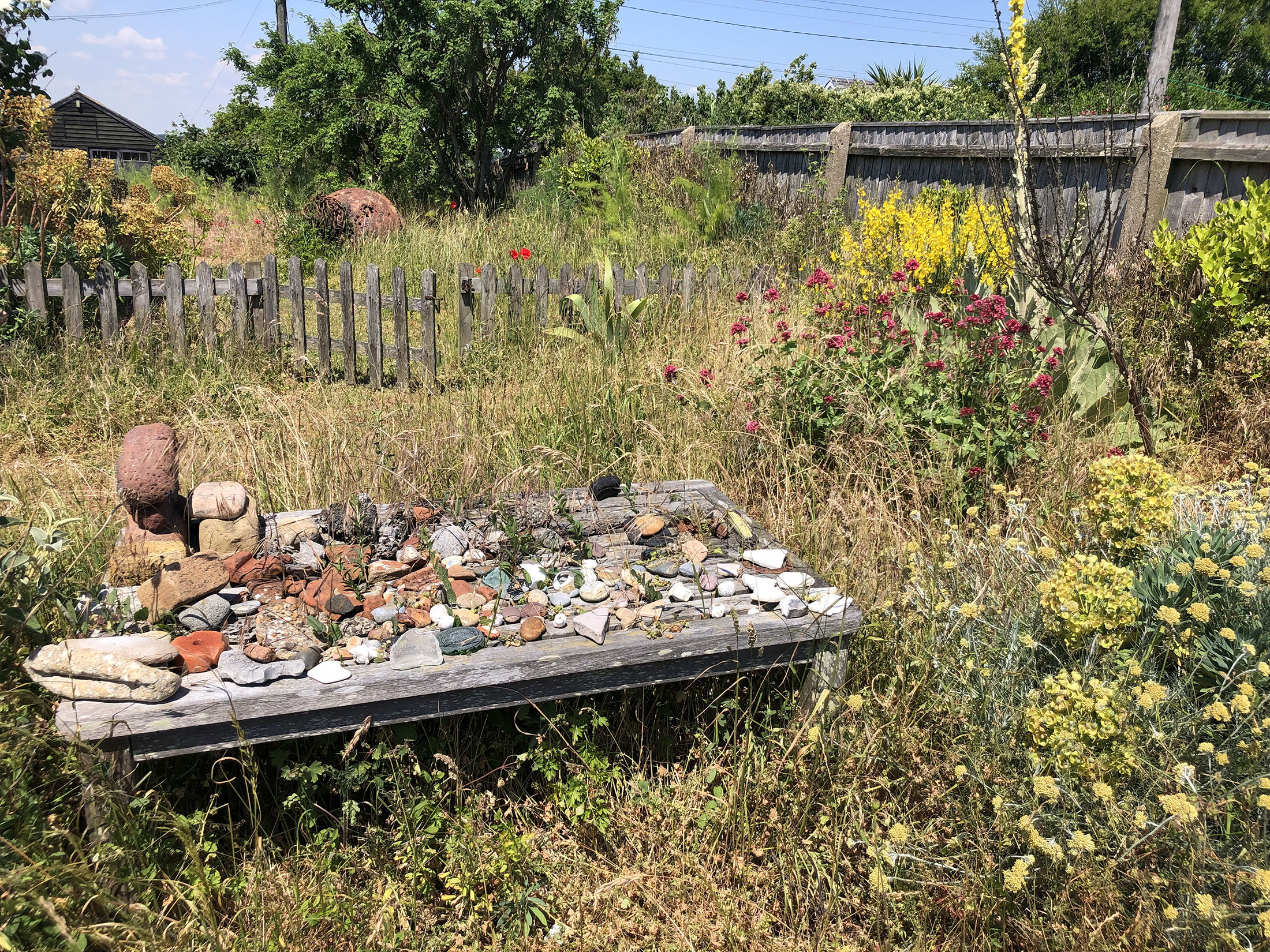Dispatch 1

By Kyra Morris
My walk from the town of Orford to the beach at Shingle Street begins with a mistake. I’m only half-way through my first cup of weak pub-coffee when I realize that the ferry I thought could take me to my starting point only runs on weekends, and it is not a weekend. There’s no other public transportation between these two points. Orford is a picturesque former fishing town with one main street of rose covered cottages, two pubs, and one excellent bakery. Shingle Street is a strip of beach with no pubs, no bakery, and just a handful of summer cottages. Without the ferry, I would need to walk an extra seven miles inland to cross the Butley River, bringing my total miles for the day from a manageable fourteen to an ill-advised twenty-one. And it is a hot June day. A very hot June day for England. So instead of walking the extra miles, I ask an Orford pub-owner for a ride to the town of Hollesley—ten miles from Orford by car, but only five further south along the coast if you could walk straight through the creeks and marshes. He lets me off at Hollesley’s 11th century Norman church: a castle-like steeple, walls faced with flint, sandstone and quartz pebbles—known here as “shingle.” These pebbles make up the beach at Shingle Street as well as the whole coastline of the county of Suffolk, England, from Lowestoft in the north to Felixstowe in the south.

This is my fourth day of walking that coastline. I began in Lowestoft, a fishing port once home to 770 boats for catching herring. Now there are more pigeons in Lowestoft than herring boats—pigeons who have made the city’s Victorian window moldings their nesting place. There is still industry in Lowestoft—primarily off-shore wind—but the city’s architecture marks its apex as long-passed. From Lowestoft, I took a winding double-decker bus ride to sea-side Southwold where I began walking in earnest—past brightly painted beach cottages with names like “Jubbly Bubbly” and “Billy Bumpkin.” From Southwold I walked on through salt marshes to postage-stamp sized Dunwich: a cluster of no more than ten houses where there was once a medieval trading port. It fell into the sea in the 13th century. Its eroded cliffs drifted thirteen miles south to the port of Orford where the remains formed a spit of shingle, closing in what had once been a sea port. From Dunwich—or what is left of it—I made my way south to that shingle spit, to Orford Ness.
For seventy-one years, Britain’s Ministry of Defence used Orford Ness to develop and test its weapons—first conventional weapons, then nuclear ones. During the Cold War, nuclear and thermonuclear bombs were vibrated, heated, cooled, and crashed against concrete on this ten-mile stretch of pebble beach. The top-secret tests were conducted without the bombs’ fissile cores, but they were dangerous all the same. Their force is visible in the concrete bunkers that dot the Ness, built to withstand 400 pounds of explosives. These former laboratories are gradually being taken over by wildflowers, weeds, and black-backed gulls. The Ness is now a National Nature Reserve that draws birdwatchers hoping to see a Spoonbill or a Lapwing, but the decaying laboratories create a landscape that generations of writers and journalists have described as “eerie,” “unsettling,” “otherworldly,” “mysterious,” and “haunted.”
Yesterday as I walked past Orford Ness, the roofs of its laboratories appeared to shape-shift as I approached—playing tricks on the eye. Today, my first destination is Shingle Street and my final destination is the port city of Felixstowe, some eight miles further south. There are no military installations at Shingle Street, unless you count the Coastguard Station that closed in 2014. As I set off, I imagine it will be less “eerie,” less “otherworldy.”
From the church in Hollesley, I follow a narrow road out toward the marsh. The road is paved but sand encroaches from either side and ten-foot hedges make it seem more path than roadway. I pass only a single dog walker before emerging from the hedge tunnel onto the marsh. Enclosure gives way to expanse, the stillness of church and hedge to the swaying of marsh grasses. I skirt brackish pools on a raised embankment until marsh grass gives way to a seemingly endless ridge of tawny pebbles. I am on Shingle Street. Beyond the ridge of pebbles, I can see just a strip of the North Sea.
I take a few steps onto the shingle and wonder if this what it feels like for seals when they try to navigate land with tail and flippers. I have never felt so ungainly on a solid surface.
I’ve been following Suffolk’s coastline for some thirty miles but have only walked on marsh grasses, boardwalks and asphalt paths. This is my first encounter with the region’s peculiar shingle landscape. I take a few steps onto the shingle and wonder if this what it feels like for seals when they try to navigate land with tail and flippers. I have never felt so ungainly on a solid surface. With each step I sink into a pebble pit of my own making, only to have to haul myself out again and repeat the process. And each step makes a racket—the dull thud of rubber sole on shingle, and then a roar and crack as flint hits quartz hits sandstone.

I look up from the pebbles and notice a green tuft a few paces off that looks—improbably—like kale. In this treeless landscape it seems as good a place as any for a rest. I haul myself over and flop down next to the aberrant vegetable. Up close, the shingle no longer appears uniformly tawny but milky-grey, rust-orange and what my high school painting teacher would have called “burnt sienna.” I pick up a caramel-colored piece, streaked with what looks like cream. Now I understand why these pebbles make for such difficult walking—they are wave-worn, smooth to the touch.
From my point of collapse next to what I later learn is a tuft of sea-kale, I can see the southern end of the spit at Orford Ness across a narrow channel of water—less than a mile away as the crow flies, but eleven by either car or foot because of the network of rivers and marshes in-between. And between me and the end of the Ness are a few crumb-like islands that used to belong to the spit—reminders of its constant movement, its shape-shifting. Orford Ness grows and shrinks depending on the direction and force of the waves that crash against the coast. Sea level rise is also already transforming the landscape, making it erode faster. The dominant wave pattern at the Ness sends shingle southward—from the southern tip of the Ness to the beach at Shingle Street. When the erosion rates at the Ness increase, an outer band of beach gets added to Shingle Street, creating a series of lagoons.
Stories, too, have drifted from Orford Ness down to Shingle Street. Because it was the site of top-secret weapons testing, Orford Ness became the site of myths: of a UFO stored in a former radar building, of Russian trawlers parked in the North Sea to block an experimental long range radar system. Shingle Street, on the other hand, did not play a strategic role in the World Wars or in the Cold War. Prior to World War I, it was on its way to becoming a resort for European aristocracy. Instead of laboratories, it had a spa center called German Ocean Mansions built to accommodate 200 guests—part of the tourist infrastructure that brought the German Empress to Felixstowe in 1891. And yet, Shingle Street has its share of war myths. It is the rumored site of a failed 1940 German invasion—a rumor that has persisted despite repeated efforts to debunk it. Those who hold to the myth say that British troops set the sea on fire to stop the invaders and that the bodies of the German soldiers washed up on the shingle beach. There’s some truth to this rumor. The British military did experiment with setting the sea on fire. But that was in 1914 at Orford Ness, not Shingle Street.
From my spot by the sea-kale, the shingle dwarfs everything else in the landscape—visual drama to match the drama of Shingle Street’s legends. I haul myself up from my resting-spot and begin to make my way south toward the abandoned coastguard station. As I trundle along the shingle—thudding and cracking with each step—I begin to notice breaks in its tawny expanse: a fox-glove-like flower the color of a grape popsicle (later I’ll learn this is “viper’s bugloss,” which sounds like the name of a metal band, not a flowering plant); delicate violet sea-pea; and a plant with a tall central stem that looks—when surrounded by the expanse of orange rock—like something out of the deserts of the American Southwest. I’m disappointed to learn that this desert look-alike is just a relative of the common lamb’s ear. But like desert plants, the flora of a shingle beach has to withstand harsh conditions: high winds, harmful salt spray, low moisture retention, and the shifting of the beach itself. Just as I’m starting to feel that I’ve wandered into a coastal desert I look toward the North Sea and decide that yes, this must be a desert because there—200 feet from me—is a red crater that looks as though it belongs in Utah. A boy is hauling his boogie board up the crater’s slope and trying to ride it down the shingle to the pool of water below.

I must have been seven or eight the first time I saw the desert. I stepped off the plane that had brought me from the leafy, close horizons of New England and felt, suddenly, very small—as if I might lose myself in the expanse of land and sky. Ever since, I’ve asked myself a version of the question Edward Abbey poses in Desert Solitaire: “What is the peculiar quality or character of the desert that distinguishes it in spiritual appeal from other forms of landscape?” Abbey—who grew up in Pennsylvania—at first finds a ready answer in the desert tropes of any temperate-region dweller: “spare, sparse, austere,” and “utterly worthless.” The draw of the desert, Abbey claims, is its paradoxical “veil of mystery”—it appears to reveal all while actually revealing nothing. It draws the viewer in with the false promise that he or she might draw open the veil to uncover the desert’s secret. Abbey’s own initial definition proves to be one such false promise. He rejects it as the figment of a romantic imagination. All he can claim about the desert, in the end, is that “there is something about the desert…”
Perhaps its apparent barrenness is not the result of absent vegetation but of the scale of the shingle landscape—and its self-similarity.
I find myself in a similar predicament here on Shingle Street—find myself wanting to call this landscape “barren,” “empty,” and “mysterious” even as I’m noticing the purple viper’s bugloss and green sea kale growing on this sun-baked, wind-scoured spit of rock. Perhaps its apparent barrenness is not the result of absent vegetation but of the scale of the shingle landscape—and its self-similarity. Because the shingle extends in all directions from the lagoon-crater, it seems to open out onto the infinite—seems like a scene in an Edward Hopper painting where a starkly lit door or window opens out onto a beyond that is also the beyond. It’s this quality that makes the place feel “barren” even though it’s not devoid of vegetation or of people (though on a scorching summer day, the crowd at Shingle Street numbered only five or six).
I continue south past the lagoon-crater toward a single row of beach cottages. This is all that Shingle Street can boast for tourist accommodation. I stop at a white line, or what looks like a white line, etched on the shingle. Maybe I’m not in a Hopper painting but an Andy Goldsworthy installation? The line is made up of shells—white whelk shells laid end to end across the shingle from where it begins at the edge of the pavement all the way down to the edge of the sea. It crosses some 900 feet of pebble beach in shell lengths—4,000 shells? 10,000? I’m tempted to follow the shell-line down to the water but can’t face the idea of having to make my way back up the shingle ridge.
Instead, I continue on toward the beach cottages. I don’t want to stop walking again. It’s getting close to midday and my pack is getting heavier, the sun hotter. It’s still eight miles to my final destination in Felixstowe. But there, piled on a bench, are fist-sized chunks of wave-worn brick and glass. Grasses poke up through the bench-slats and cast shadows on the fragments. I pause only briefly. But at another cottage down the line, someone has arranged their beach finds in a gradient from white to red to tawny and back to white. Next door is a minimalist who has placed just a handful of white whelk shells and white quartz pebbles on their table. I think of knocking on doors to try and meet these collectors, but that would break the remarkable silence of this place. The collectors of Shingle Street have already left here what they want others to know.
The collectors of Shingle Street have already left here what they want others to know.

Months after my walk on Shingle Street, I reread Edward Abbey’s Desert Solitaire. I had always read his assertion that “There is something about the desert…” as a placeholder. The ellipsis and the “something” mark an inability to name the desert’s essence— to give language to its particularity as a landscape. But contained in that placeholder is a different assertion, I now realize—one that may not have held for Abbey but does hold for Shingle Street. There is something about the desert, at least the desert at Shingle Street, that turns people to the things they can put in a pocket and then display on a picnic table, a bench, or on the shingle itself. Unlike a monument or an old postcard, these collections don’t tell us much of the site’s human history—at least not as a sequence of events. But they do tell us what people have made of this place. Out here in the expanse of the self-similar, selection is the first step toward a human scale—toward a form of understanding. Some things about the desert aren’t mysterious at all. One of them sits on my desk: a piece of caramel-colored shingle, streaked with what looks like cream.
